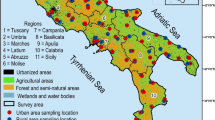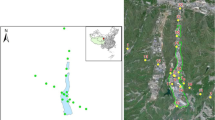Abstract
Background
Even at low residue concentrations, persistent organic pollutants (POPs) are of increasing concern all over the world. They include numerous organochlorine pesticides, like hexachlorocyclohexane (HCH), known for its toxicity, lipophilic properties and very long turnover time. To test and settle the appropriate prevention and remediation measures, there is an imperative need to delineate suspected contaminated areas and to acquire information regarding the historical and actual production, usage and storage; the probable fate and the contamination situation of these compounds in the environment.
Objective
India is a major producer and, although it officially banned HCH in 1990 for agricultural purposes, it is still permitted for the health protection programme (vector-transmitted diseases). The present report aims to address the actual contamination of soils and sediments in India with technical HCH and lindane for the period 1996-2003.
Approach
The assessment was conducted using different sources of data: beside specialized scientific databases, general search engines were used. Information was also sought by visiting websites and sending a request letter to authors of publications, in charge of NonGovernmental Organizations, international organizations, companies and Indian governmental and research institutions.
Comments
The appraisal revealed that, on a national level, there is a lack of information regarding lindane residues in soils and sediments. The description of parameters influencing residual concentrations of these compounds in soils is frequently omitted in these reports and the few investigations conducted do not cover the whole country, dismissing the Eastern and Central States. However, such a situation is not unique to India, and the information appears to be also scarce and patchy for many developing and developed countries worldwide.
Recommendations
In our opinion a harmonized sampling procedure should be agreed upon at a national level and a standard procedure for lindane measurement be set at an international level. This will allow for making comparisons between different countries and improve our understanding of lindane behaviour in soil and its management. To achieve this we need enough data and obviously data of good quality, but not only this. Geographic Information System would be a very valuable tool to gather all the available information and to assess residues of HCH and other POPs at a local, regional, national and international level.
Similar content being viewed by others
References
Rajendran RB, Subramanian AN (1999): Chlorinated pesticide residues in surface sediments from the river Kavery, South India. Journal of Environmental Science and Health Part B — Pesticides Food Contaminants and Agricultural Wastes 34, 269–288
http://www.headlice.org/lindane/index.htm
http://goidirectory.nic.in
http://www.sciref.org/links/EntDept/IndexHI.htm
http://www.icar.org.in
http://www.greenpeace.org
http://www.panna.org
http://www.toxicslink.org
http://www.ortech.ca/cgeic
http://www.chem.unep.ch/gmn/default.htm
http://www.nrtee-trnee.ca
http://www.epa.gov
http://www.usgs.gov
http://dir.indiamart.com/indianexporters/pesticid.html
http://www.indianchemicalportal.com/chemical-resources
http://www.pcilindia.com/prod/product.html
http://www.bayerchemicals.com
http://www.rallis.co.in
http://www.indiainfoline.com/comp/unph/mr01.html
http://www.pan-uk.org/banlindane/index.htm
Li YF, Cai DJ, Singh A (1998): Technical hexachlorocyclohexane use trends in China and their impact on the environment. Archives of Environmental Contamination and Toxicology 35, 688–697
Herbst M, Van Esch GJ (1991): Environmental Health Criteria 124 — Lindane. International Programme on Chemical safetyhttp:// www.inchem.org/documents/ehc/ehc/ehcl24.htm ISBN 92 4 157124 1
Rajendran RB, Venugopalan VK, Ramesh R (1999): Pesticide residues in air from coastal environment, South India. Chemosphere 39, 1699–1706
Srishti A (2000): Trojan Horses: Persistent Organic Pollutants in India. Toxics link reporthttp://www.toxicslink.org/backend/im-ages/publications/publications-l-18.pdf
Allsopp M, Johnston P (2000): ’Unseen poisons in Asia: A review of persistent organic pollutant levels in South and Southeast Asia and Oceania. Greenpeace Research Laboratories, Department of Biological Sciences, University of Exeter, UKhttp:// www.greenpeace.org ISBN: 90-73361-64-8
Edwards B, Santillo D (1996): The stranger: the chlorine industry in India. Greenpeace Research Laboratories published by Greenpeace International
Labunska I, Stephenson A, Brigden K, Stringer R, Santillo D, Johnston PA (1999): The Bhopal legacy: Toxic contaminants at the former Union Carbide factory site, Bhopal, India: 15 years after the Bhopal accident. Greenpeace Research Laboratories, Dept. of Biological Sciences, University of Exeter, UK, ISBN: 90-73361-59-1
Labunska I, Stephenson A, Brigden K, Stringer R, Santillo D, Johnston PA, Ashton JM (1999): Persistent organic pollutants and other contaminants in samples taken in the vicinity of the Hindustan Insecticide Ltd plant, Udyogmandal industrial estate, Kerala, India. Greenpeace Research Laboratories, Department of Biological Sciences, University of Exeter, UK; ISBN: 90-73361-62-1
Amaraneni SR (2002): Persistence of pesticides in water, sediments and fish from fish farms in Kolleru Lake, India. Journal of the Science of Food and Agriculture 82, 918–923
Hans RK, Farooq M, Babu GS, Srivastava SP, Joshi PC, Viswanathan PN (1999): Agricultural produce in the dry bed of the River Ganga in Kanpur, India — A new source of pesticide contamination in human diets. Food and Chemical Toxicology 37, 847–852
Nawab A, Aleem A, Malik A (2003): Determination of organochlorine pesticides in agricultural soils with special reference to gamma-HCH degradation by Pseudomonas strains. Bioresource Technology 88, 41–46
Pandit GG, Rao A M Mohan, Jha SK, Krishnamoorthy TM, Kale SP, Raghu K, Murthy NBK (2001): Monitoring of organochlorine pesticide residues in the Indian marine environment. Chemosphere 44,301–305
Singh RP (2001): Comparison of organochlorine pesticide levels in soil and groundwater of Agra, India. Bulletin of Environmental Contamination and Toxicology 67, 126–132
Sreenivasa R, Pillala RR (2001): The concentrations of pesticides in sediments from the Kolleru Lake in India. Pest Management and Science 57, 620–624
Suresh-Babu G, Farooq M, Ray RS, Joshi PC, Viswanathan PN, Hans RK (2003): DDT and HCH residues in Basmati rice (Oryza sativa) cultivated in Dehradun (India). Water Air Soil Pollution 144,149–157
Agnihotri NP (1999): Pesticide safety evaluation and monitoring. In: All Coordinated Research Project on Pesticide Residues, Division of Agricultural Chemicals, Report of the Indian Agricultural Research Institute
Agarwal HC, Singh DK (1998): Dissipation of organochlorines in Northern Indian soils. ACIAR Proceedings Series 85, 156–170
Ali I, Jain CK (2001): Pollution potential of pesticides in the Hindon River, India. Journal of Environmental Hydrology 9
Bhattacharya B, Sarkar SK, Mukherjee N (2003): Organochlorine pesticide residues in sediments of a tropical estuary, India: Implications for monitoring. Environment International 29, 598–592
Ghosh S, Das AK, Vass KK (2000): DDT, HCH and endosulfan residues in the lower stretch of river Ganga. Geobios-Jodhpur 27, 161–164
Kumari B, Singh R, Madan VK, Kumar R, Kathpal TS (1996): DDT and HCH compounds in soils, ponds and drinking water of Haryana, India. Bulletin of Environmental Contamination and Toxicology 57, 787–793
Nath BS, Usha MA, Unnikrishnan V, Galawi SR (2000): Organochlorine pesticide residues in fodder, soil and water from dairy farms. Indian Journal of Dairy and Biosciences 11, 127–130
Pandit GG, Sahu SK, Sadasivan S (2002): Distribution of HCH and DDT in the coastal marine environment of Mumbai, India. Journal of Environmental Monitoring 4, 431–434
Reddy DJ, Reddy KN, Rao BN, Sultan MA, Babu TR (1997): Residues of quinalphos G and Sevidol G [carbaryl and lindane] in soils and sugarcane juice [in Andhra Pradesh]. Journal of Research ANGRAU 25, 60–62
Sarkar A, Nagarajan R, Chaphadkar S, Pal S, Singbal SYS (1997): Contamination of organochlorine pesticides in sediments from the Arabian Sea along the West Coast of India. Water Research 31, 195–200
Senthilkumar K, Kannan K, Subramanian A, Tanabe S (2001): Accumulation of organochlorine pesticides and polychlorinated biphenyls in sediments, aquatic organisms, birds, bird eggs and bat collected from South India. ESPR — Environmental Science and Pollution Research International 8, 35–47
Singh P, Singh IP (1997): Bioefficacy and persistence of lindane residues in soil under sugarcane in Bihar. Indian Journal of Entomology 59, 278–282
Author information
Authors and Affiliations
Corresponding author
Rights and permissions
About this article
Cite this article
Courdouan, A., Marcacci, S., Gupta, S. et al. Lindane and technical hch residues in indian soils and sediments a critical appraisal. J Soils & Sediments 4, 192–196 (2004). https://doi.org/10.1007/BF02991140
Received:
Accepted:
Issue Date:
DOI: https://doi.org/10.1007/BF02991140




